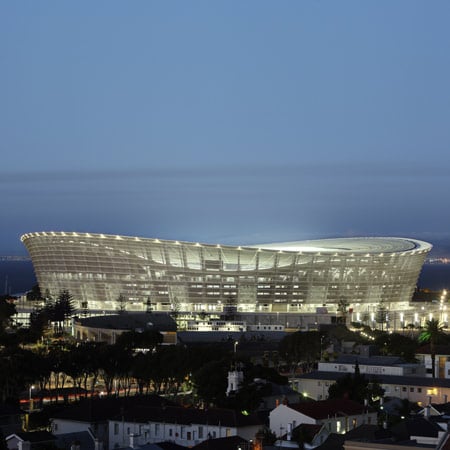
Green Point Stadium by GMP Architekten
Here’s another stadium designed by German studio GMP Architekten (see our earlier stories here and here) for the 2010 FIFA World Cup starting this week in South Africa.
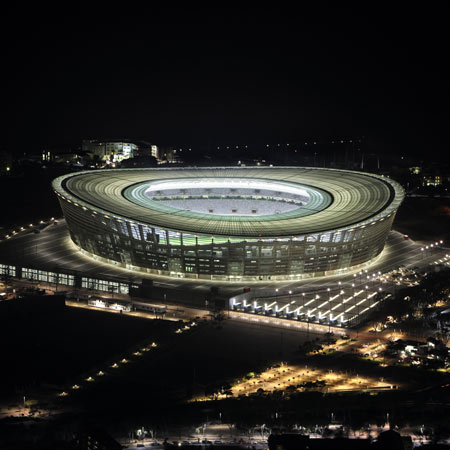
Above photograph by Bruce Sutherland
Called Green Point Stadium, the project is located in Cape Town and has a capacity of 68,000 on three tiers.
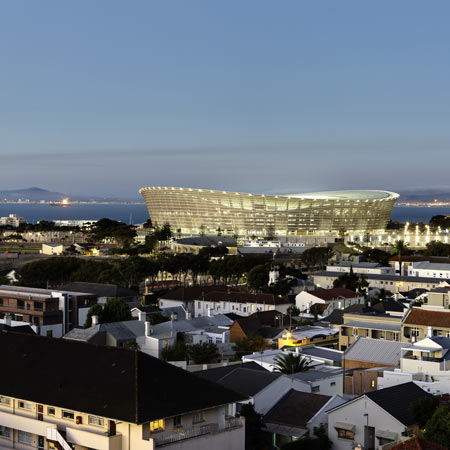
Once the 2010 FIFA World Cup is over 13,000 of these seats will be removed and replaced with suites for hire and club rooms.
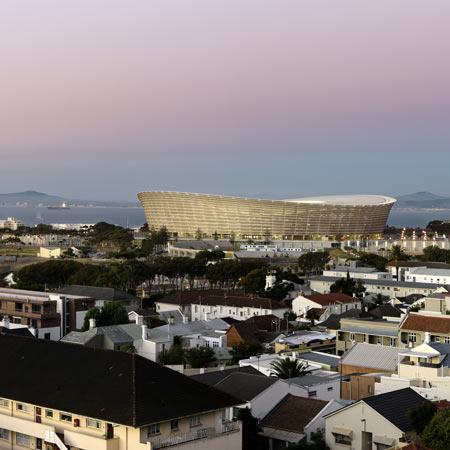
The stadium features a curved laminated glass roof with clear glass in the middle and an enameled ring on the outside to reduce heat and light intensity.
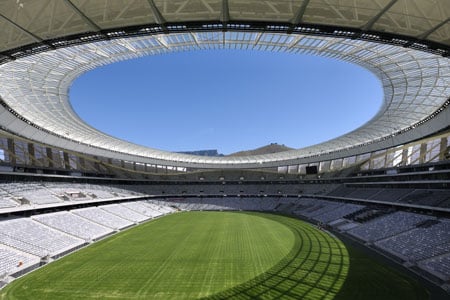
Above photograph by Bruce Sutherland.
The facades and underside of the roof are clad in a translucent glass fabric with a silver coating.
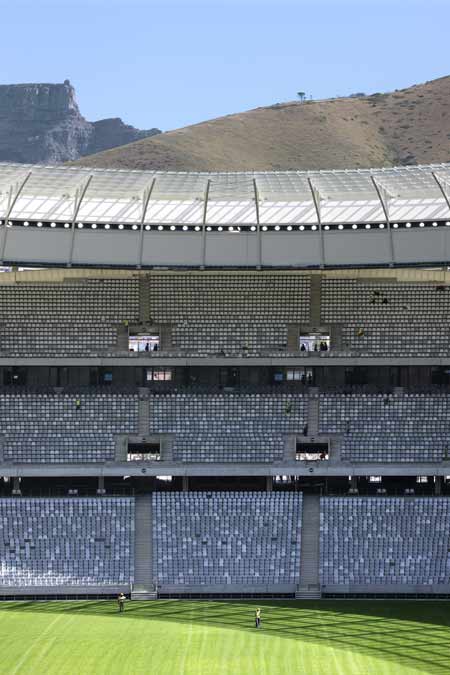
More 2010 FIFA World Cup stadiums:
Soccer City by Boogertman Urban Edge + Partners and Populous
Nelson Mandela Bay Stadium by GMP Architekten
Moses Mabhida Stadium by GMP Architekten
Here's some more information from GMP Architekten:
Cape Town Stadium, Cape Town, South Africa
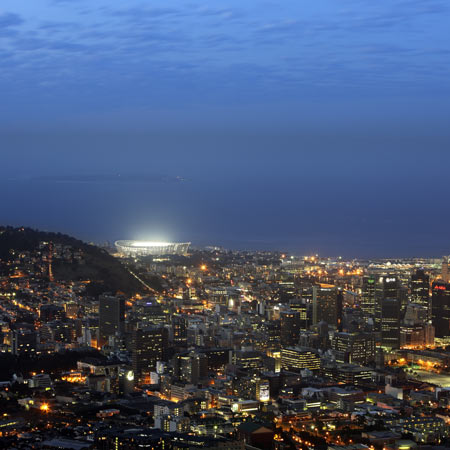
The skyline of Cape Town is dominated by Table Mountain, Signal Hill and the Atlantic Ocean. Cape Town Stadium forms a landmark at the foot of Signal Hill, and fits respectfully into its environment. The challenge was to create a standalone building in this unique location that enriches rather than mars the world-famous picture-postcard setting.

Above photograph by Bruce Sutherland
Specifically, the job was to design a stadium on part of Green Point Common, an 80ha public park in the city center that would become iconic of Cape Town. The Common also contains South Africa’s oldest golf course and oldest rugby club. It is surrounded by residential areas, and is close to Cape Town’s central business district on the old Victoria & Alfred Waterfront, which is now the city’s main tourist attraction.
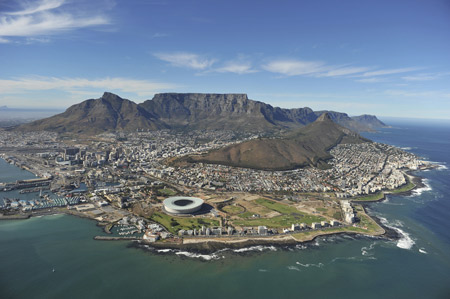
Green Point Common has history in Cape Town. It was a rocky wasteland until, in 1923, the government of the Union of South Africa made it over to the city as common land on which recreational areas and sports facilities would be set up. Over the past decades, the area of common land has been whittled away, most of it no longer being accessible to the public, having been leased to private sports clubs and other organizations.
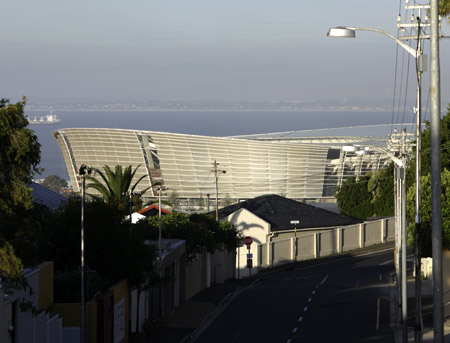
After careful political consideration, it was decided to locate the stadium so as to forge a link between the commercial center and Green Point Common, and reorganize the existing sports facilities. Fort Wynyard artillery fort, Green Point cricket ground and the golf club were integrated into the public park.
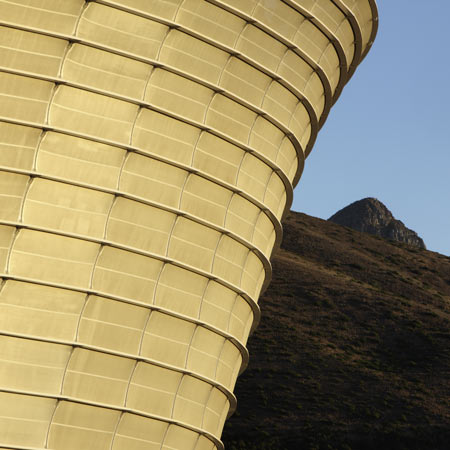
Together with the horizontal line of Table Mountain and the rounded top of Signal Hill, the curving contours of the stadium act as a kind of bottom note in a harmonious triad. Lightweight in concept, the circular stadium comes across as unobtrusive and respectful of its surroundings. Its appearance varies greatly with the typical lighting conditions of the area. With its translucent external skin, it reacts to different weather and daylight conditions at different times of the day or seasons, and diverse lighting effects give it a sculptural look.
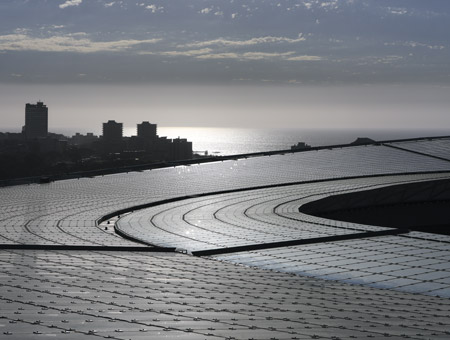
This design concept was combined with the purely functional requirements. For spectators, it provides a logical but sensory structure, and inside the stadium engenders a terrific atmosphere during soccer and rugby matches and concerts alike. The stadium provides seats for 68,000 spectators, arranged on three tiers, 2,400 of them for business and a further 2,500 in boxes. Broad access promenades on Levels 2 and 6 form “lobbies” round the stadium arena, allowing visitors freedom of movement, a pleasant environment to linger in and ease of orientation round the stadium. The pitch is visible from the “lobby”. The upper “lobby” at a height of 25m offers a panoramic view over Green Point Common, the city and the ocean.
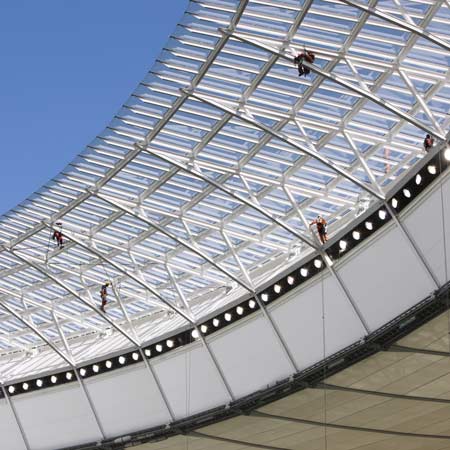
The parabolic profile of the stands gives all spectators an optimal view of the pitch. The strongly curving outline of the top tier contrasting with the more muted curves of the roof edge is a result of their functional geometry. During the 2010 soccer World Cup, temporary rows of seating will be installed on either side on the top tier, but these are due to be replaced later by events suites and clubrooms. That will reduce seating capacity from 68,000 to 55,000 but increase the number of rentable areas, so as contribute to the commercial viability of the stadium post-World Cup.
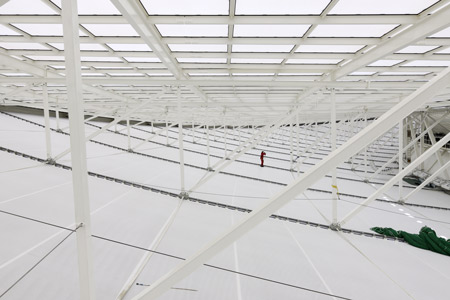
One critical objection to the politically motivated location in a small-scale setting was the height of the stadium. Due to the rocky subsoil, the pitch and bottom tier could not be sunk into the ground. To reduce the apparent height of the stadium, therefore, we provided an elevated plateau as an artificial land-scape feature that mediates between the surroundings and the stadium and lessens the perceived height of the stadium. Broad ramps and steps on three sides lead up to this plateau, under which is parking space for over 1,200 cars, a goods delivery area and access for fire engines and emergency services.
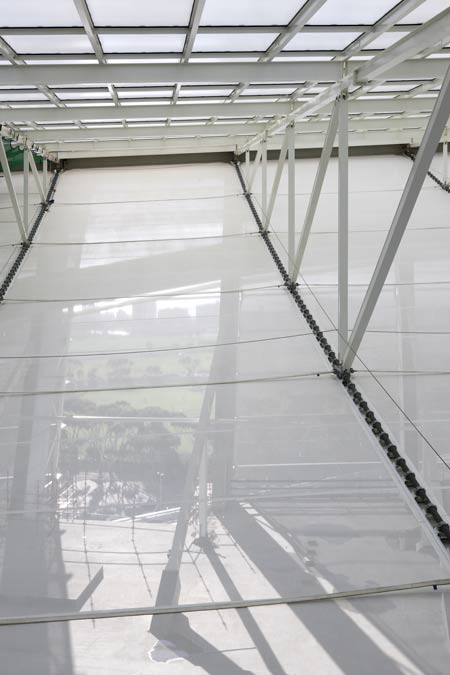
The need to weigh down the flat suspended roof against aerodynamic uplift and achieve rainwater runoff without pumps prompted us to come up with an innovative structural solution: a synthesis of a saddle-shaped, curved suspension roof and a truss-girder system, with heavy glass roofing to prevent wind suction upwards.
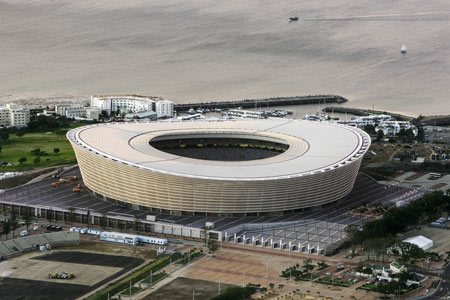
These steel truss girders on load-bearing cables form the core of a roof structure clad on both sides. The 36,000m² roof is made of laminated glass. The inner, 16m-wide ring consists of clear glass so that the pitch gets a lot of natural light, while the external glass areas are enameled, to reduce heat dissipation and cut the light intensity by about 80%. The underside of the roof structure is, like the façades, clad with a translucent membrane, which not only covers the technical installations but also provides sound insulation. The loudspeaker system, floodlighting and stand lighting systems were integrated into the roof. Despite the total glass weight of 4,500 tons, the roof is still a lightweight structure compared with roofs of similar size.
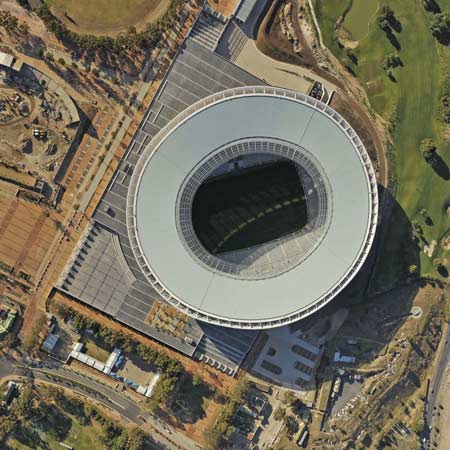
Above photograph by Bruce Sutherland
The façade was designed as a horizontally profiled membrane. Its undulating silhouette transforms the stadium into a large-scale, translucent sculpture. The membrane is a semi-transparent glass fabric with a silver coating, enveloping the load-bearing structure like a veil while allowing glimpses of the interior. In the highly changeable weather conditions in Cape Town, it offers frequently changing reflections—like the changing light conditions and moods of the day: white and light on bright summer days and shrouded in grey on stormy winter days. At sunset, the stadium is bathed in a reddish glow. At night, it gleams like a Chinese lantern, revealing its interior.
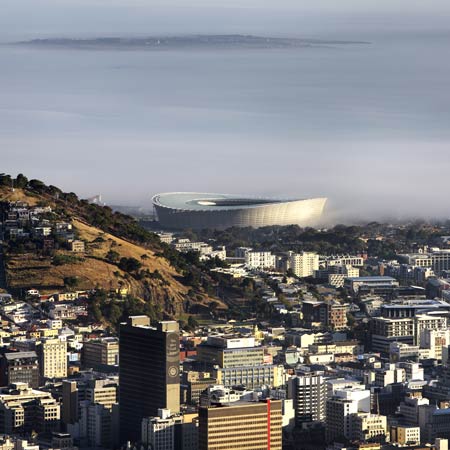
Cape Town’s world-famous skyline has acquired a new architectural feature. The new stadium has unobtrusively taken its place in the impressive urban landscape of the Cape of Good Hope and in the hearts of South African citi-zens whatever their ethnic origin.
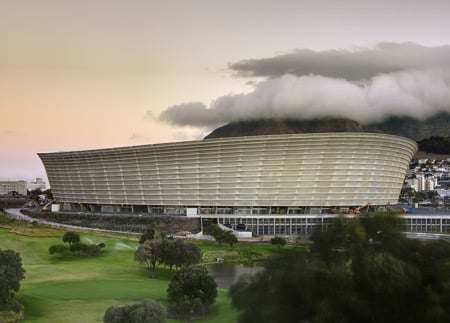
See also:
.
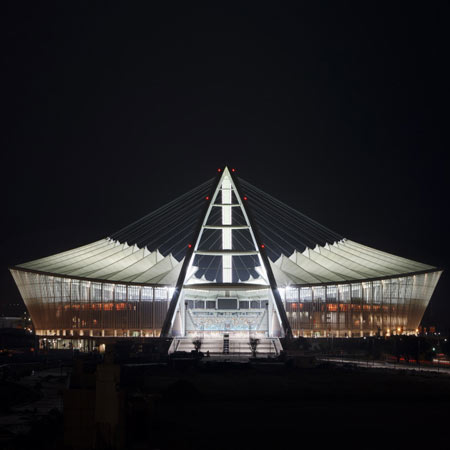 |
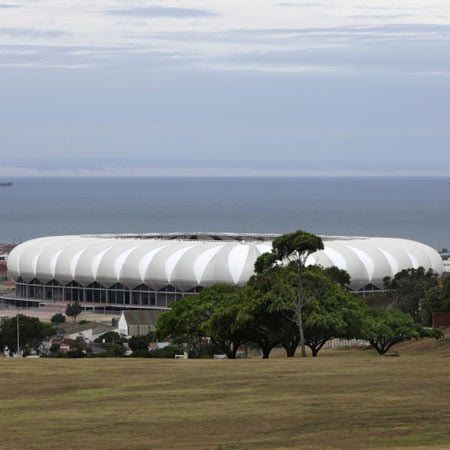 |
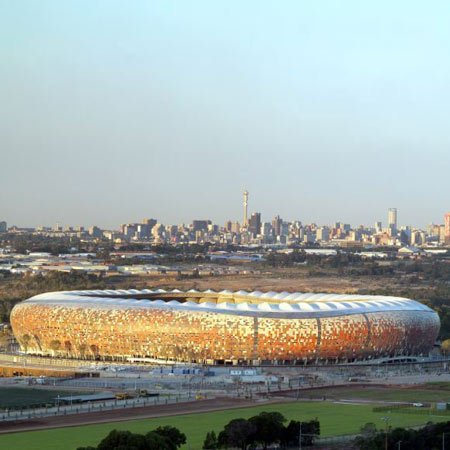 |
| Moses Mabhida Stadium by GMP Architekten |
Nelson Mandela Bay Stadium by GMP Architekten | Soccer City by Boogertman Urban Edge and Populous |